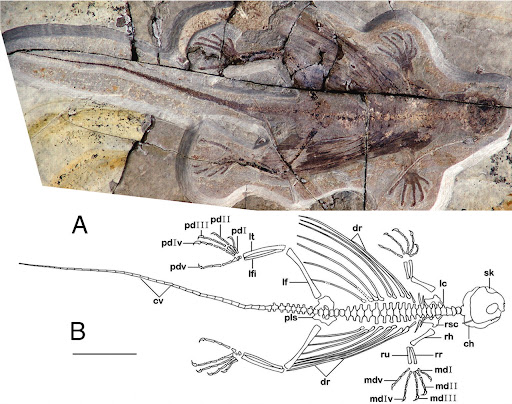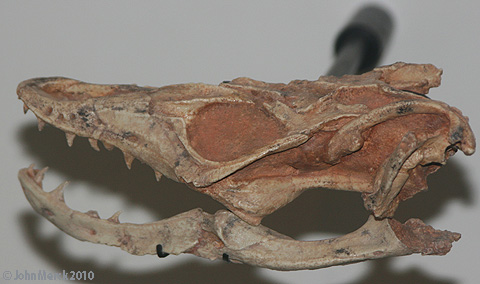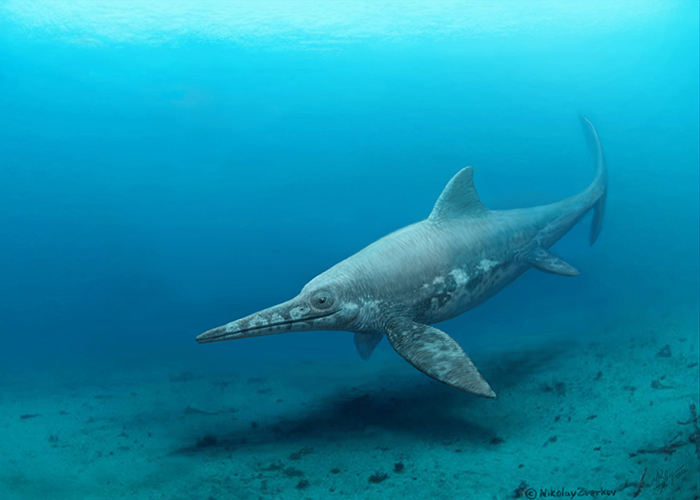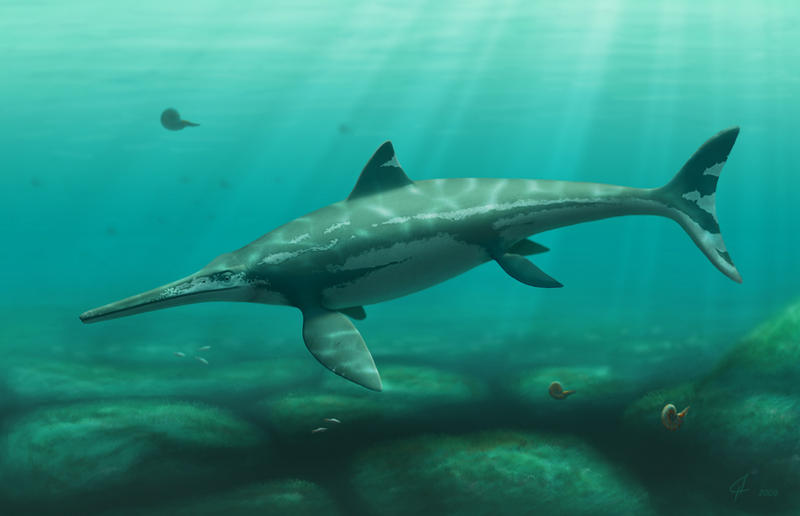[Recent Entries][Archive][Friends][User Info]
November 16th, 2013
| November 16th, 2013 | |
|---|---|
| 04:18 pm [industrialterro] [Link] |
Xianglong Xianglong (meaning "flying lizard" in Chinese) is a genus of Cretaceous lizard discovered in the Liaoning Province of China. It is known from LPM 000666, a single complete skeleton with skin impressions. The specimen comes from the Barremian-age Lower Cretaceous Yixian Formation, near Yizhou. The most notable feature about Xianglong is its bizarre oversized ribs, eight on each side, which were attached to a membrane of body tissue and allowed the lizard to glide. It was an acrodont lizard, and a cladistic analysis indicates it was grouped with iguanians such as agamines, chamaeleonids, and leiolepidines. The fossil specimen found was 15.5 centimetres (6.1 in) long, 9.5 centimetres (3.7 in) of which was tail, but the describers say it was a juvenile. So far this is the only known fossil gliding lizard, though there are other unrelated animals that also use their ribs to glide. Xianglong is one of the few creatures that glide using their ribs. Other creatures, such as the flying squirrel and the Malabar Flying Frog, Rhacophorus malabaricus, have a different membrane attachment, toes to toes or limb to limb. Two creatures use the same way to glide, the present day Flying Lizard (genus Draco, Latin for dragon) and Triassic fossil reptiles such as Kuehneosaurus, but the Triassic look-alikes lived over 100 million years before Xianglong. Despite the 11-centimeter(4.3 in) "rib-span", the lizard might have been quite agile in the air, possibly to escape the feathered dinosaurs that coexisted with it. Xianglong had slightly curved claws, indicating that it was arboreal. Of course, it needed to be in order to get in its "gliding mode". Xu Xing, a Chinese paleontologist and one of the describers of Xianglong, states that it is possible Xianlong could have glided as much as half a football field, much farther than that of the modern Draco.
Tags: Вымершие рептилии, Мел, диапсиды, игуанообразные, лепидозавроморфы, лепидозавры, чешуйчатые, ящерицы |
| Time | Event |
| 04:50 pm [industrialterro] [Link] |
Estesia Estesia (in honour of Richard Estes) is an extinct genus of Late Cretaceous helodermatoid lizard found in the Gobi Desert in Mongolia. It was discovered in June 1990 by a joint expedition made up of Mongolian and American palaeontologists, and described in 1992 by Mark Norell, Malcolm McKenna and Michael Novacek. This animal is very interesting, not only because it's close to the lineage of modern Gila monsters (Heloderma), but also because its dentition shows evidence that it was venomous. The type species is E. mongoliensis, after Mongolia, where it was found. Material for Estesia has been collected in various localities in the Gobi Desert, including the Barun Goyot Formation, the Djadochta Formation and Ukhaa Tolgod. IGM M3/14 (holotype): A well-preserved skull with mandible, from Lizard Hill, Khulsan (Barun Goyot Formation) IGM 3/15: Partial skeleton with associated braincase, from Khermeen Tsav (Barun Goyot Formation), discovered in 1993 and described by Norell and Gao in 1997. In the description, Estesia was assigned to Varanoidea, as the sister group to Varanidae, based on skull characters. However, the new material found in 1993 provided evidence that not only Estesia was not closely related to modern varanids, it was actually a distant relative of Gila monsters. The phylogenetic analysis presented by Norell and Gao (1997) actually supported the creation of a new group that included modern Gila monsters and extinct pre-historic forms, the Monstersauria. The teeth of Estesia were sharp and recurved, like in modern varanoids. Interestingly, these teeth possess longitudinal grooves that run both from the anterior and posterior tooth surfaces during the entire tooth length. Similar characteristics are present in the teeth of Gila monsters.
Tags: Вымершие рептилии, Мел, диапсиды, лепидозавроморфы, лепидозавры, чешуйчатые, ящерицы |
| Time | Event |
| 05:09 pm [industrialterro] [Link] |
Platypterygius Платиптеригий (Platypterygius) — ихтиозавр мелового периода, последний по времени обитания из описанных по обнаруженным окаменелостям представителей группы. Крупный ихтиозавр, длиной до 9 метров. Череп низкий, с длинной мордой, небольшой орбитой, длинным посторбитальным отделом. Максилла чрезвычайно удлинена спереди. Зубы массивные, с квадратными в сечении корнями. Чешуйчатой кости нет. Септомаксилла окостеневшая. Затылочный мыщелок полусферический. Стремя массивное, с закругленной головкой (согласно некоторым исследованиям, животное было глухим). Первые три шейных позвонка срослись. В переднем плавнике чрезвычайно развита гиперфалангия и гипердактилия — число пальцев достигает 10). Фаланги в виде однообразных полигональных косточек. Тазовый пояс плохо известен, вероятно, редуцирован. Хвостовой плавник относительно невысокий, тело довольно длинное. Возможно, имелись какие-то органы кожной чувствительности (типа боковой линии) — на это может указывать структура костей черепа. Питался мелкой добычей (рыба, головоногие), что подтверждают и остатки содержимого желудка австралийского вида. Род широко распространен в первой половине мелового периода — с барремия по турон, известен как из Северного Полушария (Европа, Россия, Северная Америка), так и из Южного (Австралия и Аргентина). Не менее 11 видов, разделяемых на 4 подрода: Platypterygius, Longirostria, Tenuirostria, Pervushovisaurus. Типовой вид — P. (Platypterygius) platydactylus, из апта Германии, описан Бройли в 1907 году. Хорошо изучен австралийский вид P. (Longirostria) longmani из апта — турона Австралийского мелового моря. Это крупный (до 7 метров длиной) длинномордый вид. Первые остатки описаны как Ichthyosaurus austrialis МакКоем в 1867—1869 годах. Вид установлен М. Уэйдом в 1988 году. К роду может принадлежать также P. hercynicus из поздней юры Баварии. P. steleodon происходит из готерива-баррема Ульяновской области, описан по фрагментам челюстей и позвоночного столба. P. birjukovi известен по большей части черепа и позвоночного столба из баррема Ульяновской области. Отличается весьма крупными зубами. Орбиты низкие. Хорошо заметны вдавления на носовых костях (возможно, следы каких-то рецепторов). Длина черепа более 70 см. P. bedengensis описан по черепу и передней части скелета из готерива Ульяновской области. Длина около 5 метров. Чрезвычайно близок к австралийскому P. longmani, отличаясь деталями строения кисти. P. (Pervushovisaurus) bannovkensis — из среднего сеномана Саратовской области, описан по неполному черепу. Череп необычайно низкий и длинный, до 1,3 метра длиной. Орбиты низкие, сам череп уплощен. Рыло массивное, хорошо заметны ямки на ростре. Вероятно, последний из ихтиозавров, происходящий уже из позднемеловых отложений. Синонимы рода: Myobradypterygius, Myopterygius, Plutoniosaurus, Simbirskiasaurus. Платиптеригий интересен как последний по времени из классифицированных ихтиозавров и до недавнего времени, единственный из описанных меловых представителей группы. Австралийский и аргентинский виды могли обитать в относительно холодных полярных морях. Platypterygius ('Flat wing (flipper)', von Huene 1922) was an ichthyosaur of the family Ophthalmosauridae. It is most closely related to the genera Caypullisaurus and Brachypterygius. Fossils are known from Australia, Russia, United States of America, Colombia, Western Europe and possibly New Zealand. There are seven named species. Both adults and juveniles have been unearthed, including newborns and pregnant females. Like other ichthyosaurs, Platypterygius gave live birth. The remains from Australia were originally called Ichthyosaurus australis. They are from the Toolebuc Formation and Allaru Mudstone (Albian, Lower Cretaceous) of Flinders River and other localities in north central Queensland. In 1990 Wade erected the species name P. longmani to include all remains previously referred to I.australis . Platypterygius reached a length of about 7 m (23 ft). It had a long snout and a powerful finned tail. There are more digits in the front flippers than is usual in ichthyosaurs; they are tightly bound in rows, giving a broad, flat appearance. This unusual characteristic gives the genus its name, meaning 'flat wing.' Furthermore, some of the wrist bones have disappeared entirely. CAT scans on a juvenile specimen strongly suggest that Platypterygius was deaf. ( Read More ) Репродукции (1, 2, 3, 4, 5, 6):
Ископаемые останки (1, 2, 3, 4):
Tags: Вымершие рептилии, Мел, диапсиды, ихтиозавры, ихтиоптеригии, офтальмозавриды, платиптеригии |
| Previous Day | 2013/11/16 [Archive] |
Next Day |

















